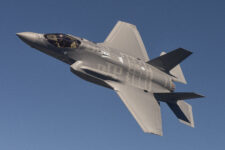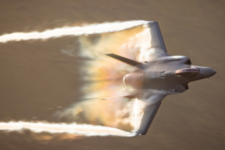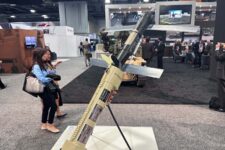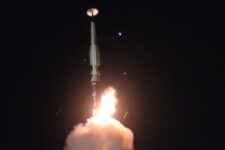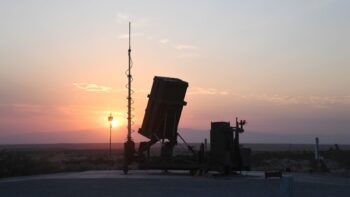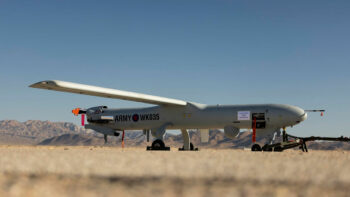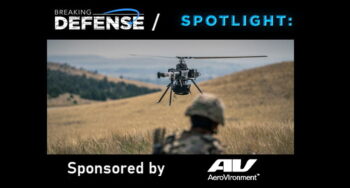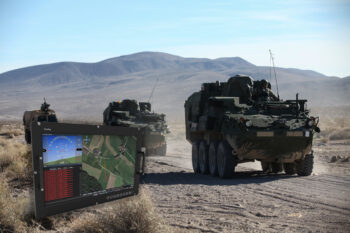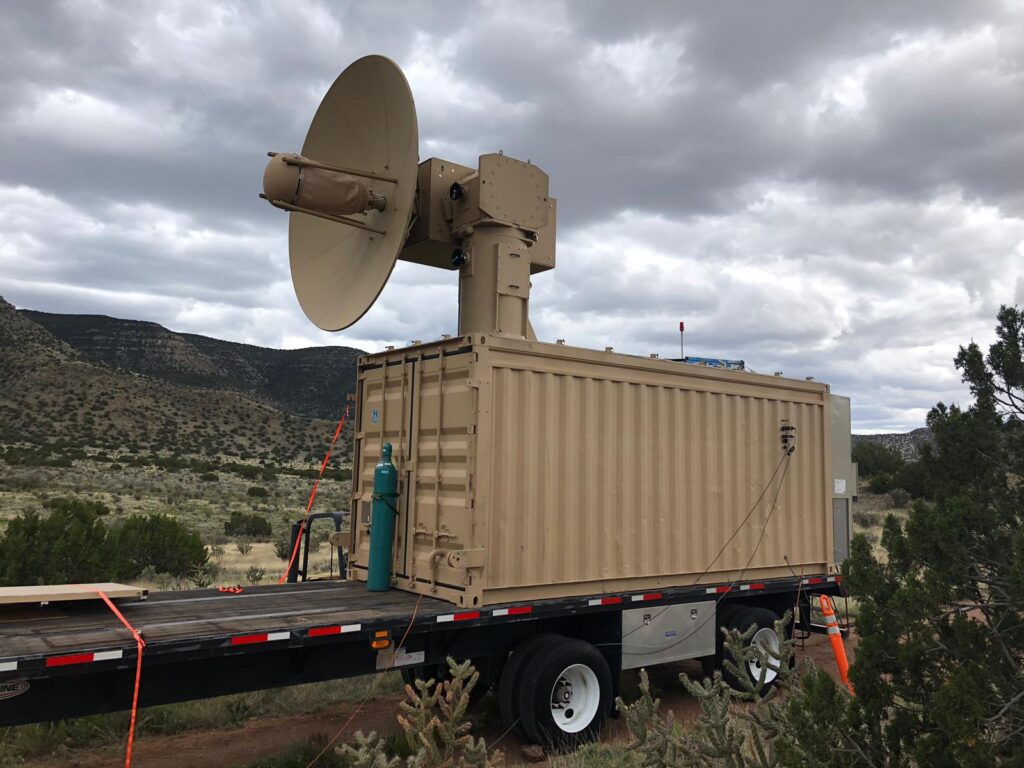
The Air Force’s THOR high-powered microwave is designed to burn out swarms of attacking drones.
WASHINGTON: The Air Force will send its Tactical High Power Microwave Operational Responder (THOR) overseas this fall for operational field experiments, with Army warfighters in particular keen to get their hands on drone-killing systems. In fact, the Army has so much confidence in the Air Force’s microwave experiments that it’s decided to focus its own R&D dollars on lasers and let the Air Force take the lead developing microwave weapons that might be used by both services.
Despite some complications and delays caused by the COVID-19 pandemic, the service is “in the process of sending systems over” for the test, Kelly Hammett, head of directed energy at Air Force Research Laboratory (AFRL), told Breaking D in an interview last week. “THOR is at Kirtland still — it’s going through checkout testing — [but] in the fall, it’s supposed to go.”
“The Air Force has done a lot of great work,” said Craig Robin, a former AFRL scientist himself who’s now the lead expert on directed energy at the Army’s Rapid Capabilities & Critical Technology Office (RCCTO). “Right now the Army’s not investing any money in high powered microwave systems,” he told Breaking Defense. “We’re working to coordinate … not only with the Air Force but with the newly established joint Counter-UAS office to ensure that we’re building a common high-powered microwave system.”
Hammett and Craig both spoke to Breaking Defense ahead of this year’s Virtual Space & Missile Defense Symposium.
Hammett demurred from providing details on the upcoming deployment citing operational security concerns — saying only that the idea is to operate THOR in theater against “active” real-world threats for a year.
However, Army Maj. Gen. Sean Gainey, Joint Counter Small Unmanned Aerial Systems (C-sUAS) Office, said in March that Central Command was the priority for early prototyping of counter-drone systems. The C-sUAS office, which launched in January, is charged by Defense Secretary Mark Esper to winnow down the 40-odd counter-drone systems under development across DoD — ranging from net guns to lasers to HPM systems — to find the best matches to various warfighter needs.
THOR uses high-powered microwaves to shoot swarms of small unmanned aerial vehicles out of the sky. It was designed in-house by AFRL for the service’s high-priority base defense mission. As Breaking D readers are aware, enabling “logistics under attack,” including figuring out how to protect bases, is one of the Air Force’s top-four priorities for the future.
“We looked at a use case for a forward air base — a FOB — something like you might find in the Middle East,” Hammett said, and for protection of “a global strike, or a nuclear base, mission” to create the requirements for THOR.
The Air Force is still grappling with its base-protection requirements and plans, Hammett said, with Air Force Life Cycle Management Center (AFLCMC) developing an acquisition strategy. But the Army is perhaps the most keen among the services to get its hands on microwave drone-killing capabilities.
Lt. Gen. Neil Thurgood, head of the Army RCCTO (and Robin’s boss), told the annual Space and Missile Defense (SMD) Symposium last August that the service was planning for to demonstrate a microwave weapon in 2022 and field four prototype vehicles in 2024. The Army wants a truck-mounted system that can be set up to defend “fixed or semi-fixed” sites like command posts and fuel depots. It’l be part of a larger system called the Indirect Fire Protection Capability (IFPC) that will include not only the microwave but a high-powered laser and conventional interceptor missiles.
Hammett and Robin explained that high-powered microwaves and lasers use very different physics, giving each advantages and disadvantages against different types of targets. A laser basically acts like a long-range blowtorch, applying heat to a precise spot — ideally something critical like a tail fin — until the target melts, burns, or just stops working. A microwave emits radiation that scrambles electronic circuitry.
“Imagine your wireless router at home, multiplied times a trillion, so instead of giving your cellphone and computer internet, it fries the electronics,” Robin said. “It’s not effective against dumb munitions like a mortar or even a rocket” — but drones can’t fly if their electronics don’t work.
HPM systems are particularly effective against large swarms of small drones because they can fire again and again in rapid succession, each zap affecting an arc much like a shotgun blast. Lasers are less effective against swarms because their needle-thin beams need some time to burn through the fuselage of each incoming drone in turn, taking down one target at a time
On the other hand, lasers can hit targets at significantly longer ranges — that makes them more suitable against higher-end drones that operate alone or in small numbers. The Army also wants the IFPC laser to be powerful enough to shoot down cruise missiles, a type of target that’s — at least for now — too difficult for microwaves.
AFRL is working with contractors BAE Systems, Leidos and Verus. They’ve been funded since 2018 by DoD’s Office of Research and Engineering (R&E) to prototype and test THOR, based on decades of painstaking research on various ways of generating microwaves, Hammett said. The money was provided through R&E’s rapid prototype program funding.
“It’s part of our secret sauce,” he said. “One of the benefits of having military laboratories is we actually do have in-house design expertise.
“We spent 20 years developing digital design codes that allow us to rapidly design microwave sources of various kinds, build prototypes, and then test in the laboratory and validate our models,” he explained. “If they work in the lab, then we can we put them in a catalog, and they’re available for later use to potentially go put into systems. And so that’s what we did here. We probably have 10 or 12 different designs of different types of microwave sources.”
The THOR program settled on an S-band source specifically tailored to defeat drones.
Housed in a 20-foot shipping container that’s transportable on a C-130, THOR can rapidly ‘refire’ extremely high-power pulses of microwave energy while slewing across sectors of the sky to rapidly take down swarms of Group 1 and 2 drones — those weighing less than 55 pounds, operating below 3,500 feet, and at speeds below 250 knots.
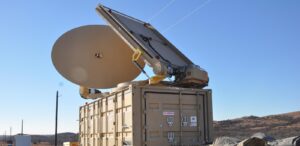
Raytheon’s PHASER high-powered microwave system
THOR isn’t the only directed energy C-sUAS system currently undergoing operational field testing, however. The Air Force’s Strategic Development Planning & Experimentation (SDPE) Office, which leads service field experiments, announced in April that it was also deploying Raytheon’s High Energy Laser (HELWS) and High Power Microwave (PHASER) prototypes for overseas testing.
Hammett said THOR’s key differentiator from comparable systems is that it was designed specifically for the needs of military operators in the field. For example, he said, it’s robust enough to withstand wide temperature swings and operate rain or shine. And it’s easy to set up.
“Basically, it comes in a big box — a 20-foot transportainer and it fits entirely in that box,” he said. “The pedestal rises out of the box, and the antenna consists of six metal plates that can be fastened together by two guys with a screwdriver and a wrench.”
Israel likely partner for Greece as it looks for integrated air defense systems
A pair of sources told Breaking Defense that Greece is in the fact-finding process of what systems Israeli might be willing to sell, as Athens looks for multi-layered air defense options.
